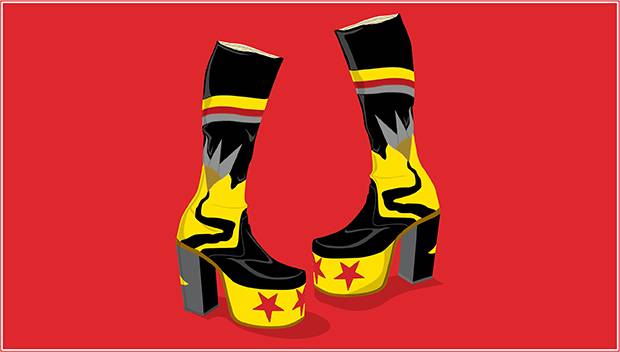To mark Canada 150, Globe Style's Clearly Canadian series explores iconic examples of domestic design.
After the Bata Shoe Museum's 2015-2016 exhibition Standing Tall: The Curious History of Men in Heels showcased a bold star-spangled pair of his platforms from 1973, Master John went viral. But not much is known about the shoe designer – he insisted that John Master was his real name, but few articles or traces of him exist. In the 1970s, Master operated a store on Toronto's Yonge and Wellesley strip (first at 611 Yonge St., then at 513 Yonge St.) and his modern plant at Danforth and Main Street claimed a capacity of 600 pairs a week until one day in the late 1970s, when an ad in this newspaper solicited a buyer for the equipment and remaining inventory.
Similarly fashionable footwear clomped around the world at the time, designed by the likes of Ferradini (outfitter to Elton John) and Kansai Yamamoto (the man responsible for David Bowie's tottering beauties). Master John was Canada's disco diva answer to English rock 'n' roll cobbler Terry de Havilland, who also made all his shoes by hand. All these designers created vertiginous novelty footwear festooned with metallic leather, snakeskin and suede carved into elaborate and often whimsical patterns.
The elaborate but impractical extreme glam rock platform (and its more moderate Kork-Ease sandal counterpart) was a stylistic throwback, first to the elevator heels of the late 1930s and 1940s but also to the raised overshoe common in the 19th century that strapped on to hold feet away from filthy, muddy streets. The overshoe's more elegant fashion precursor was the chopine, elevated footwear worn as a sign of status in 15th- and 16th-century Venice, where the wealthy women who wore them teetered in up to 20-inch platforms and had to be flanked by servants in order to walk around.
At the height of the platform's popularity in the mid-1970s, Master sold 300 pairs of his handmade shoes a week (priced from $58 to $1,800 for outlandish custom work). He claimed clients that included rockers Black Sabbath (their 36-inch thigh high snakeskin boots covered in stars and moons could be the antecedent of Balenciaga's thigh-high boots this season), actor Christopher Lee, who purportedly added another 16 inches to his statuesque frame, and the choice of southern Ontario's trendy teens, like the ones who appeared on Citytv's monthly dance show Boogie.
The now-famous platform boots from the Bata exhibit are adorned with cutouts and appliqué stars, boast 5.5-inch heels and depict a stylized sunrise on the horizon (presumably the brow of dawn after an all-night dance party at Toronto hotspot the Manatee, where they were often worn). "Many, many people say that they wore them but few seem to have kept them," says Elizabeth Semmelhack, the Bata's senior curator and author of Shoes: The Meaning of Style, an upcoming book about footwear and the construction of social identity. Despite their popularity, the Bata's extensive permanent collection only boasts two pairs. The most recent example is said to have been made for Gene Simmons, says Semmelhack, and legend has it that because they were never picked up by the KISS frontman, they were eventually sold to a local teenager who shared the pair with his brother before donating them to the museum. According to Semmelhack's research, Master John seemed to have been quite a character: "His designs were clearly desirable and many today still remember going in his shop and lusting after a pair, but his career only seemed to last as long as platforms were in style."
Master John's boots are kissing cousins to another skilled footwear maker from the 1970s named John – Fluevog. The Vancouver native's fanciful sky-high studded intricate leather designs first appeared on wooden clogs at his Fox & Fluevog label and, later, the Munster: a similarly extreme platform with a sculptural Louis XIV heel and pilgrim buckle that became popular during the house and underground DJ scene of the 1990s. Unlike its previous incarnation, the platform was again favoured by women such Lady Miss Kier of Deee-Lite (worn in the band's Groove is in the Heart music video and on the cover of the album World Clique) and strutted in by Madonna during her Blonde Ambition tour and in the documentary Truth or Dare.
The theatricality and glamorous decadence of the platform embraced by Bowie, Prince and female performers is now being championed by men again, from Quebecois designer Rad Hourani's unisex heels to Alessandro Michele's striped four-inch frankensneakers for Gucci. And while Master John is long gone, John Fluevog's Munster endures. The style has been revived this season as the strappy and only slightly more demure Dee. The last days of disco play on.
Visit tgam.ca/newsletters to sign up for the Globe Style e-newsletter, your weekly digital guide to the players and trends influencing fashion, design and entertaining, plus shopping tips and inspiration for living well. And follow Globe Style on Instagram @globestyle.
